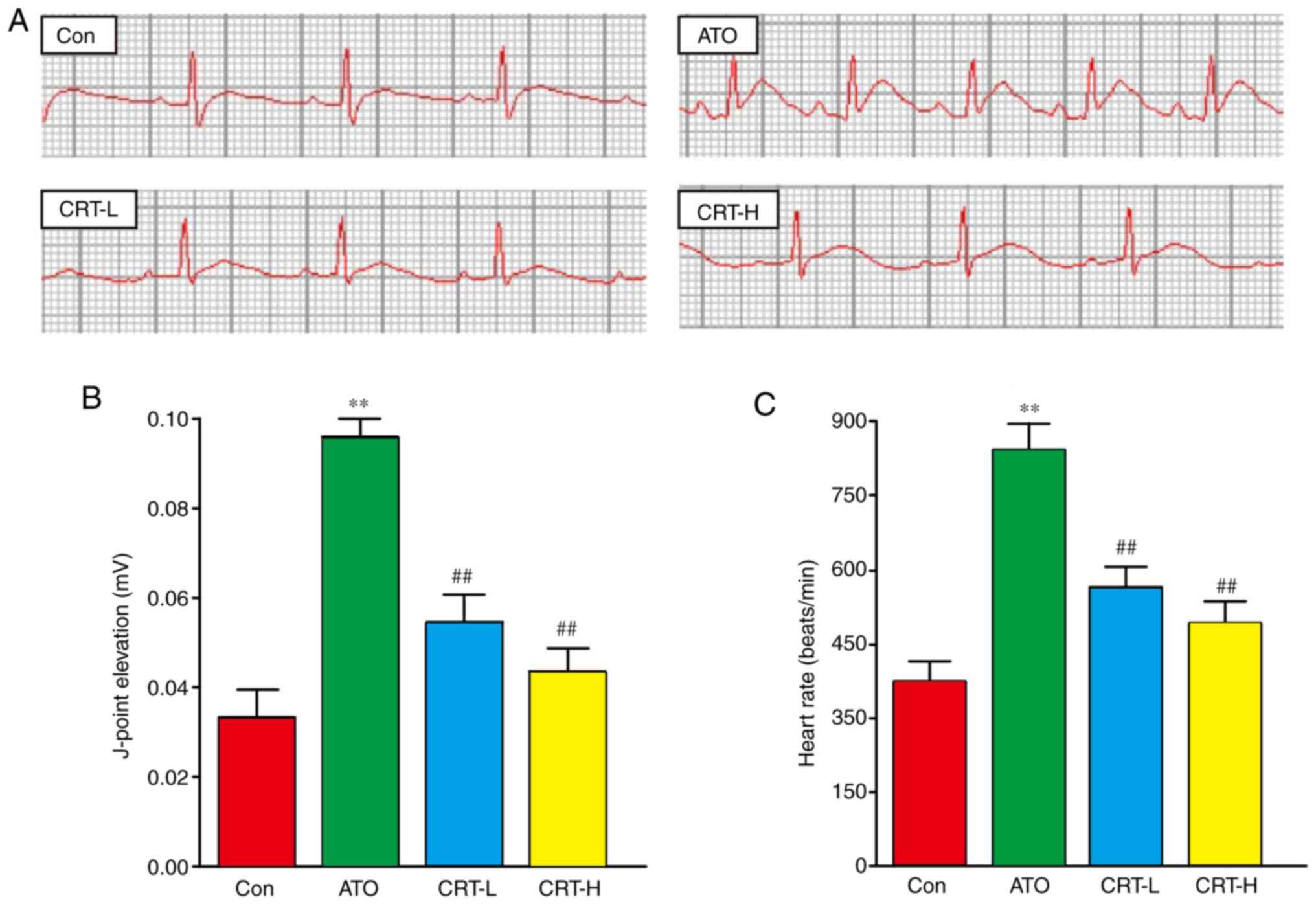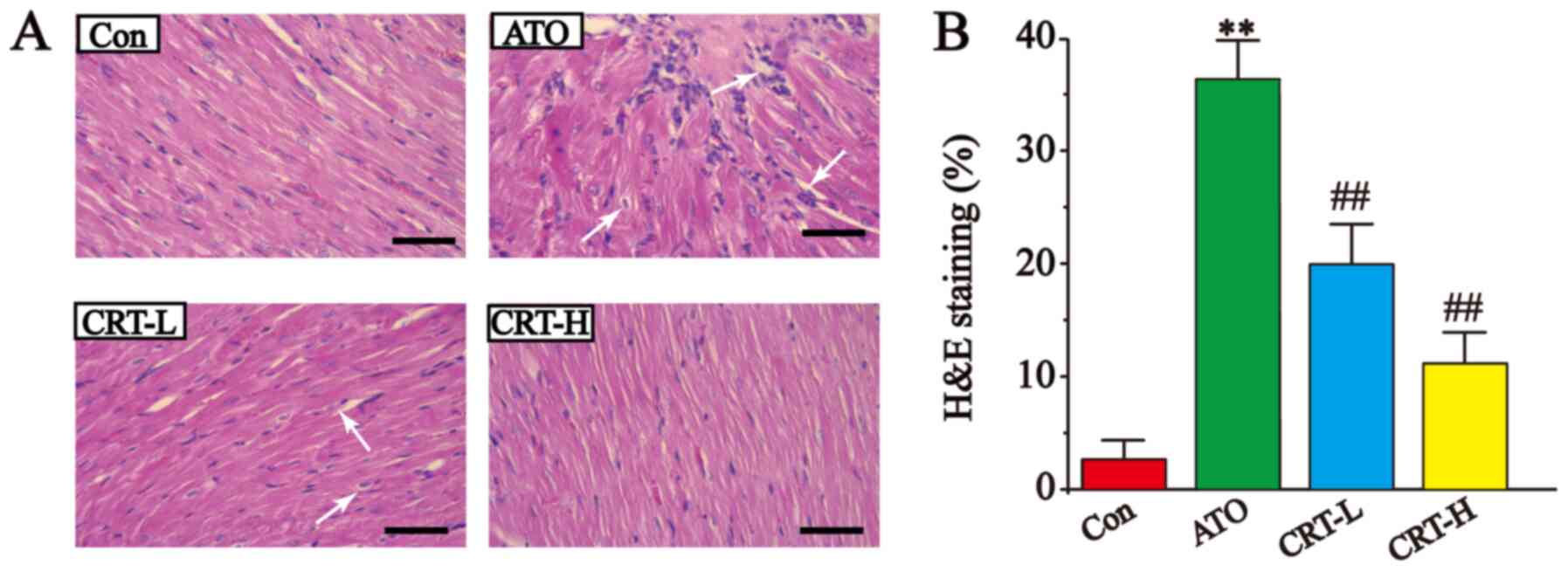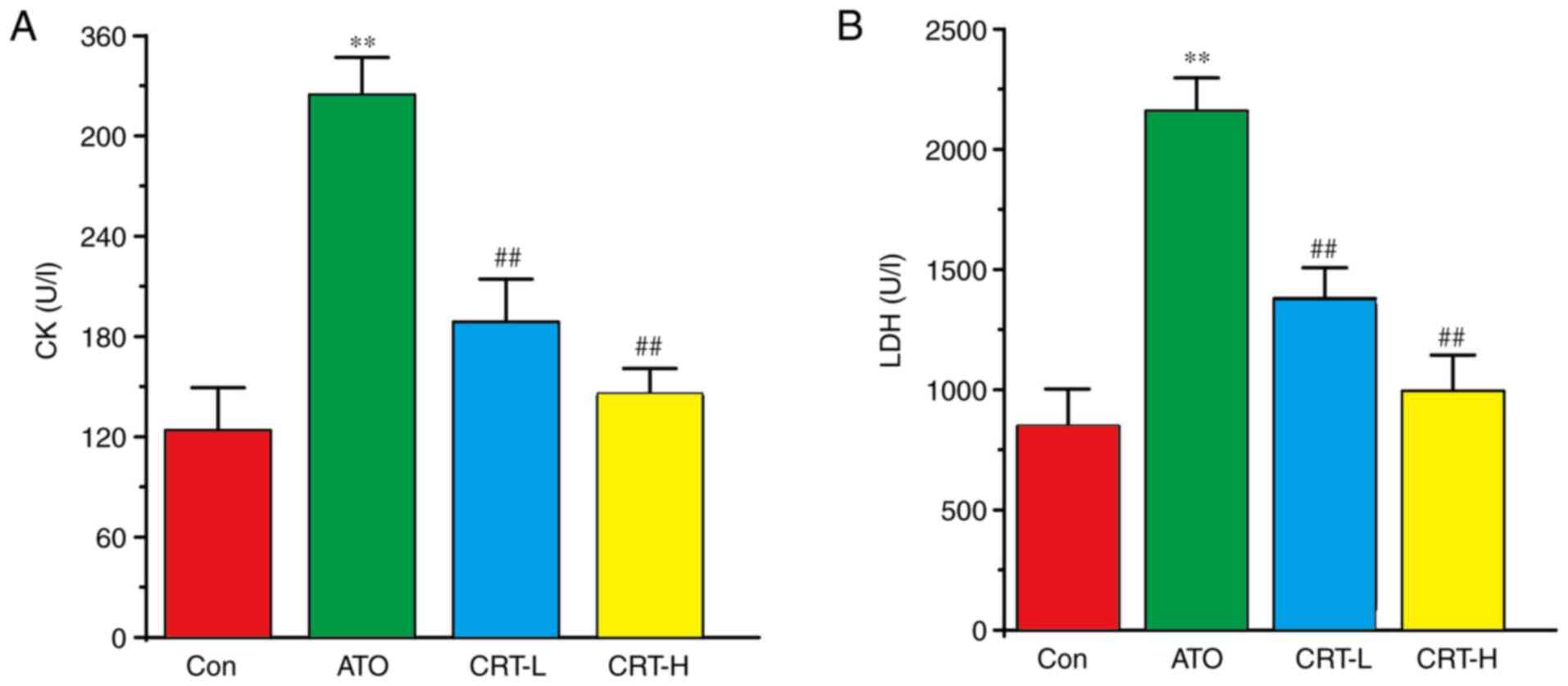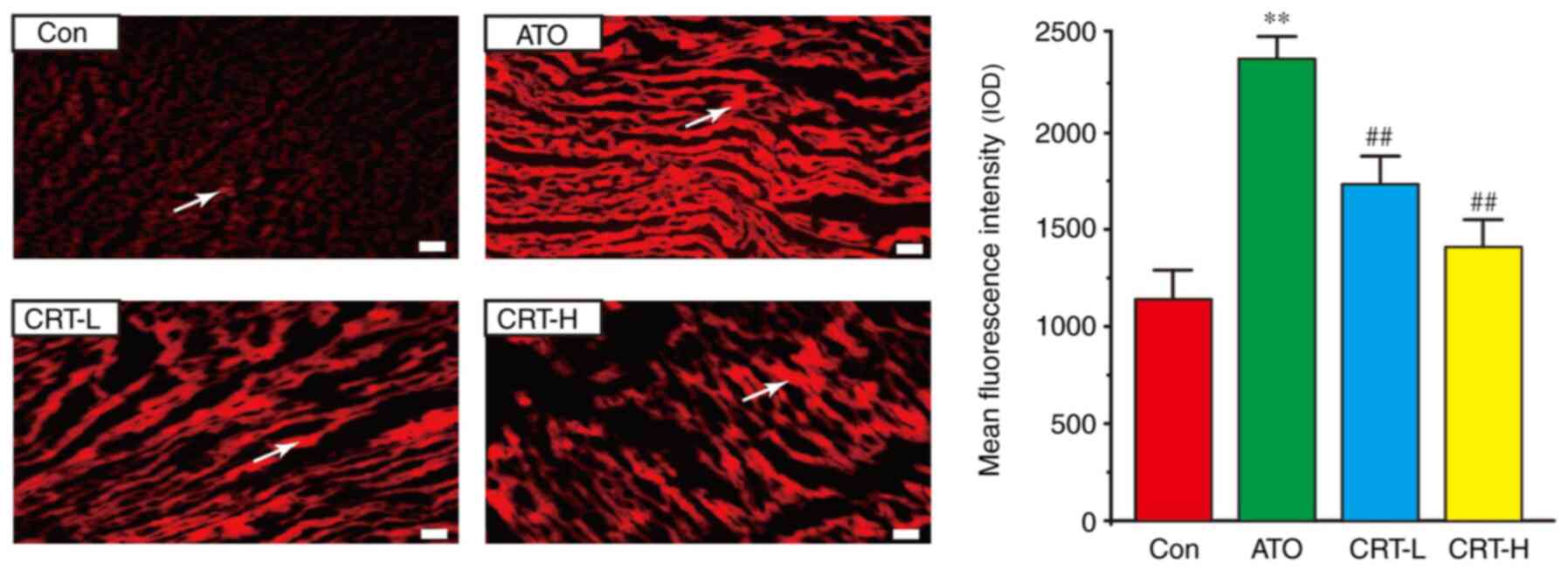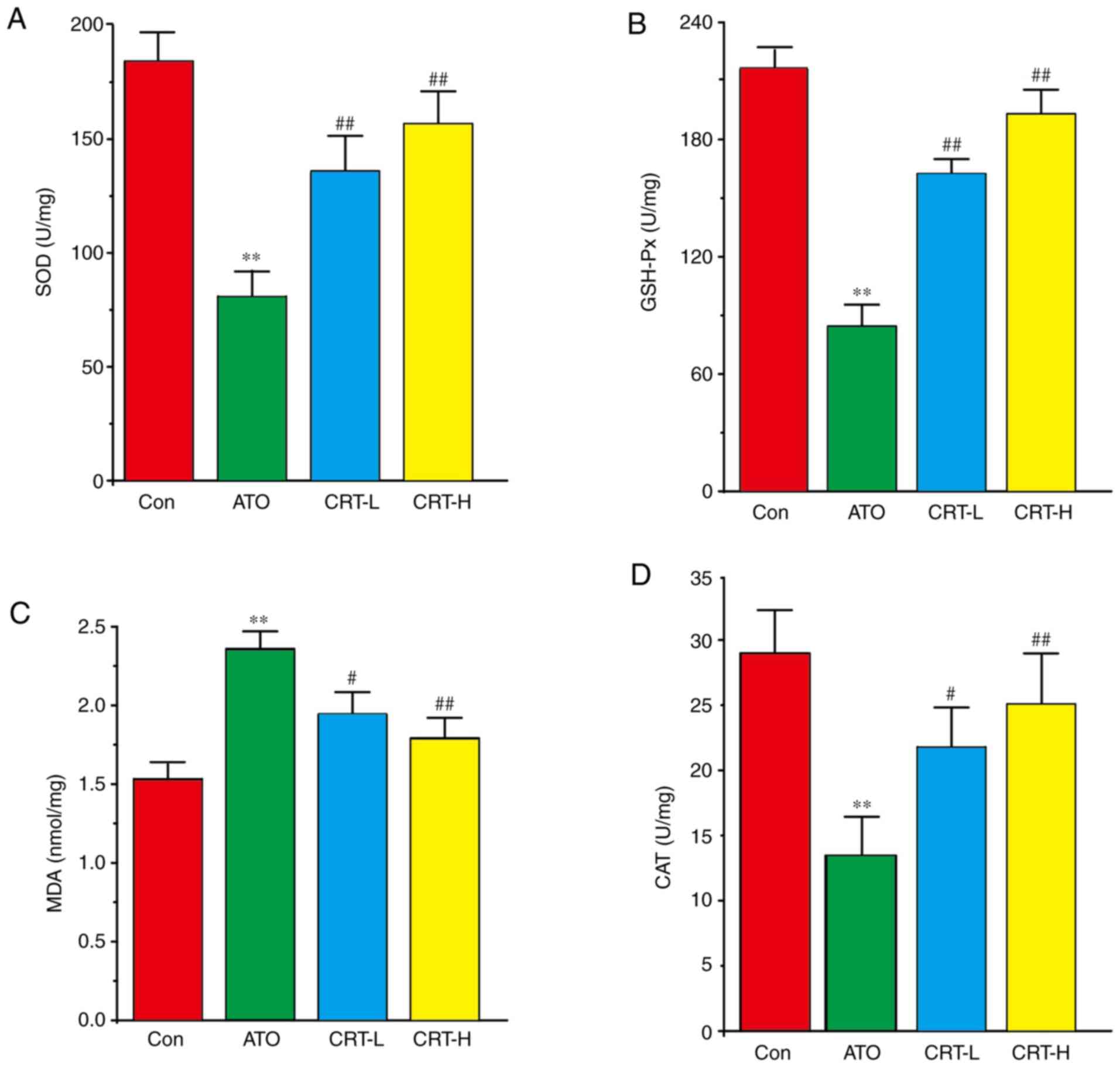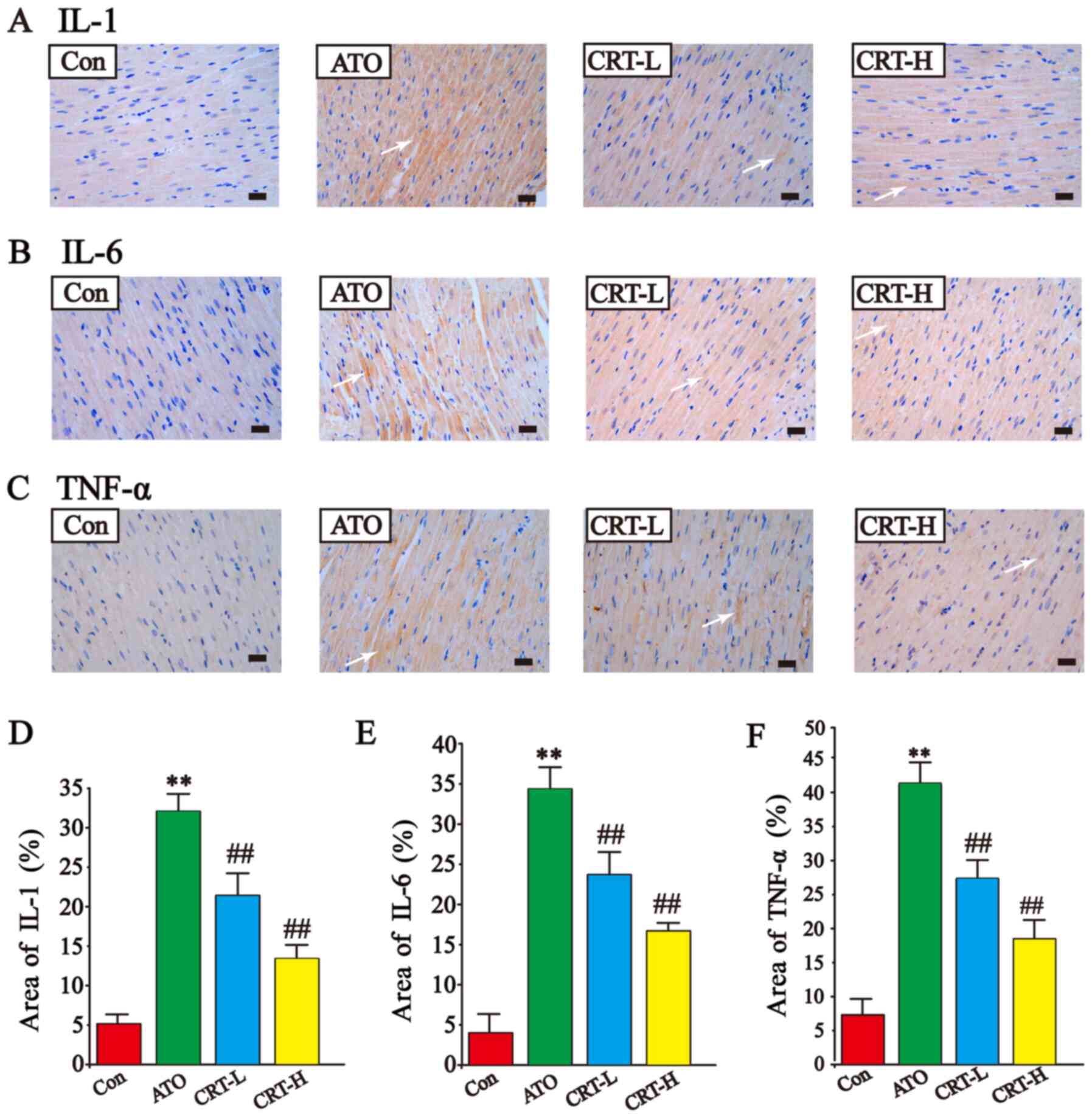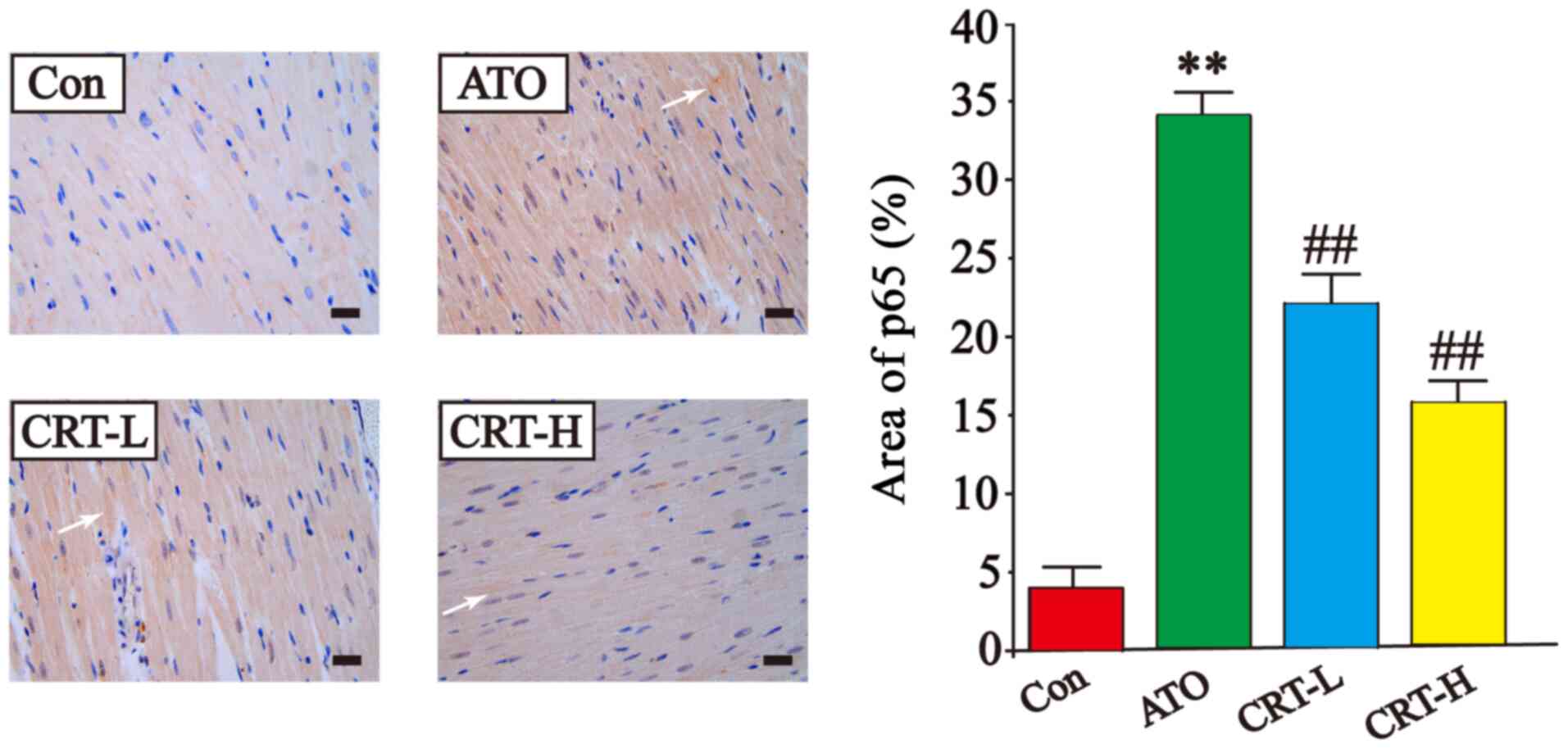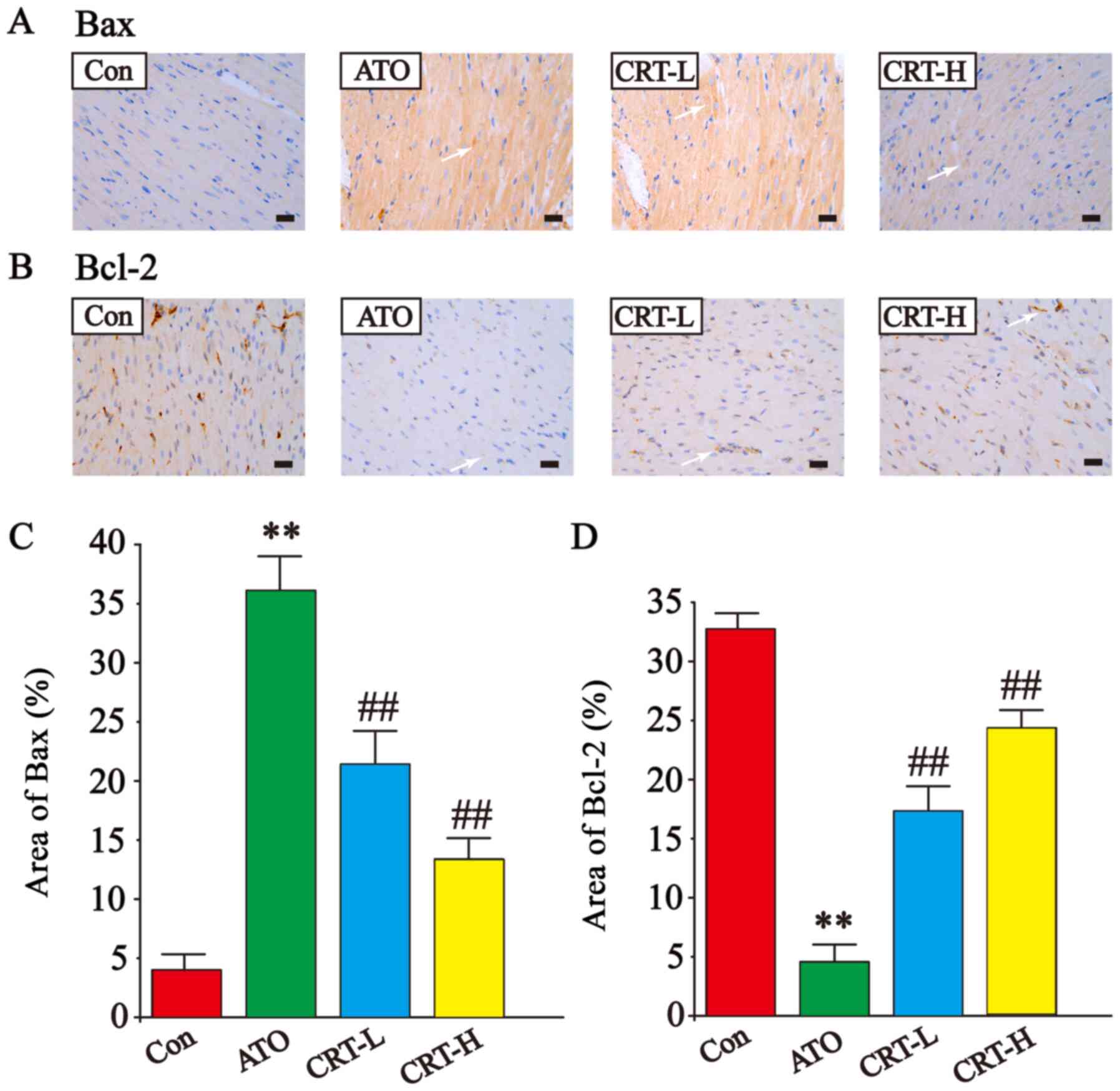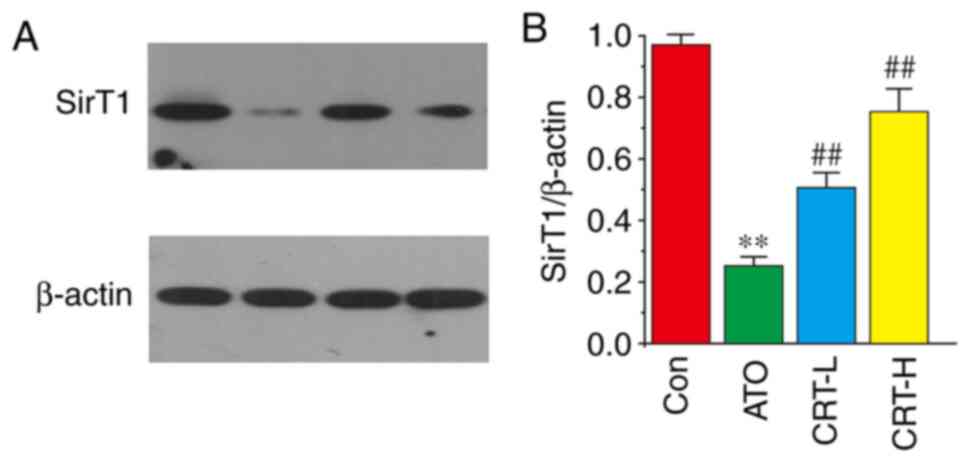|
1
|
Rao Y, Li R and Zhang D: A drug from
poison: How the therapeutic effect of arsenic trioxide on acute
promyelocytic leukemia was discovered. Sci China Life Sci.
56:495–502. 2013.PubMed/NCBI
|
|
2
|
Sfaxi I, Charradi K, Limam F, El May MV
and Aouani E: Grape seed and skin extract protects against arsenic
trioxide induced oxidative stress in rat heart. Can J Physiol
Pharmacol. 94:168–176. 2016.PubMed/NCBI
|
|
3
|
Yu X, Wang Z, Shu Z, Li Z, Ning Y, Yun K,
Bai H, Liu R and Liu W: Effect and mechanism of Sorbus
pohuashanensis (Hante) Hedl. Flavonoids protect against arsenic
trioxide-induced cardiotoxicity. Biomed Pharmacother. 88:1–10.
2017.PubMed/NCBI
|
|
4
|
Raghu KG and Cherian OL: Characterization
of cytotoxicity induced by arsenic trioxide (a potent anti-APL
drug) in rat cardiac myocytes. J Trace Elem Med Biol. 23:61–68.
2009.PubMed/NCBI
|
|
5
|
Varghese MV, Abhilash M, Paul MV, Alex M
and Nair RH: Omega-3 fatty acid protects against arsenic
trioxide-induced cardiotoxicity in vitro and in vivo. Cardiovasc
Toxicol. 17:109–119. 2017.PubMed/NCBI
|
|
6
|
Manna P, Sinha M and Sil PC:
Arsenic-induced oxidative myocardial injury: Protective role of
arjunolic acid. Arch Toxicol. 82:137–149. 2008.PubMed/NCBI
|
|
7
|
Zhang W, Guo C, Gao R, Ge M, Zhu Y and
Zhang Z: The protective role of resveratrol against arsenic
trioxide-induced cardiotoxicity. Evid Based Complement Alternat
Med. 2013:4078392013.PubMed/NCBI
|
|
8
|
Abeyrathna P and Su Y: The critical role
of Akt in cardiovascular function. Vascul Pharmacol. 74:38–48.
2015.PubMed/NCBI
|
|
9
|
Wang Z, Yu J, Wu J, Qi F, Wang H, Wang Z
and Xu Z: Scutellarin protects cardiomyocyte ischemia-reperfusion
injury by reducing apoptosis and oxidative stress. Life Sci.
157:200–207. 2016.PubMed/NCBI
|
|
10
|
Galano A: Free radicals induced oxidative
stress at a molecular level: The current status, challenges and
perspectives of computational chemistry based protocols. J Mex Chem
Soc. 59:231–262. 2015.
|
|
11
|
Zhou SS, He F, Chen AH, Hao PY and Song
XD: Suppression of rat frizzled-2 attenuates
hypoxia/reoxygenation-induced Ca2+ accumulation in rat
H9c2 cells. Exp Cell Res. 318:1480–1491. 2012.PubMed/NCBI
|
|
12
|
Andrades ME, Ritter C and Dal-Pizzol F:
The role of free radicals in sepsis development. Front Biosci
(Elite Ed). 1:277–287. 2009.PubMed/NCBI
|
|
13
|
Baird AM, OByrne KJ and Gray SG: Reactive
oxygen species and reactive nitrogen species in epigenetic
modifications. Biochem Soc Trans. 437–455. 2012.
|
|
14
|
Edson KZ and Rettie AE: CYP4
enzymes as potential drug targets: Focus on enzyme multiplicity,
inducers and inhibitors, and therapeutic modulation of
20-hydroxyeicosatetraenoic acid (20-HETE) synthase and fatty acid
ω-hydroxylase activities. Curr Top Med Chem. 13:1429–1440.
2013.PubMed/NCBI
|
|
15
|
Nakayama H, Chen X, Baines CP, Klevitsky
R, Zhang X, Zhang H, Jaleel N, Chua BH, Hewett TE, Robbins J, et
al: Ca2+- and Mitochondrial-dependent cardiomyocyte
necrosis as a primary mediator of heart failure. J Clin Invest.
117:2431–2444. 2007.PubMed/NCBI
|
|
16
|
Zhang J, Zhang Y, Wang W, Li C and Zhang
Z: Double-sided personality: Effects of arsenic trioxide on
inflammation. Inflammation. 41:1128–1134. 2018.PubMed/NCBI
|
|
17
|
Gasparini C and Feldmann M: NF-κB as a
target for modulating inflammatory responses. Curr Pharm Des.
18:5735–5745. 2012.PubMed/NCBI
|
|
18
|
Li S, Wang Y, Zhao H, He Y and Xing M:
NF-κB-mediated inflammation correlates with calcium overload under
arsenic trioxide-induced myocardial damage in Gallus gallus.
Chemosphere. 185:618–627. 2017.PubMed/NCBI
|
|
19
|
Saad SY, Alkharfy KM and Arafah MM:
Cardiotoxic effects of arsenic trioxide/imatinib mesilate
combination in rats. J Pharm Pharmacol. 58:567–573. 2006.PubMed/NCBI
|
|
20
|
Sepand MR, Razavi-Azarkhiavi K, Omidi A,
Zirak MR, Sabzevari S, Kazemi AR and Sabzevari O: Effect of
acetyl-l-carnitine on antioxidant status, lipid peroxidation, and
oxidative damage of arsenic in rat. Biol Trace Elem Res.
171:107–115. 2016.PubMed/NCBI
|
|
21
|
Miao X, Tang Z, Wang Y, Su G, Sun W, Wei
W, Li W, Miao L, Cai L, Tan Y and Liu Q: Metallothionein prevention
of arsenic trioxide-induced cardiac cell death is associated with
its inhibition of Mitogen-activated protein kinases activation in
vitro and in vivo. Toxicol Lett. 220:277–285. 2013.PubMed/NCBI
|
|
22
|
Zhao X, Feng T, Chen H, Shan H, Zhang Y,
Lu Y and Yang B: Arsenic trioxide-induced apoptosis in H9c2
cardiomyocytes: Implications in cardiotoxicity. Basic Clin
Pharmacol Toxicol. 102:419–425. 2008.PubMed/NCBI
|
|
23
|
Testai L, Piragine E, Piano I, Flori L and
Calderone V: The citrus flavonoid naringenin protects the
myocardium from ageing-dependent dysfunction: Potential role of
SIRT1. Oxid Med Cell Longev. 2020:46502072020.PubMed/NCBI
|
|
24
|
Pirola RC and Elmslie RG: Exchange
transfusion and liver perfusion in the treatment of acute hepatic
coma. Med J Aust. 1:891–894. 1968.PubMed/NCBI
|
|
25
|
Mu W, Zhang Q, Tang X, Fu W, Zheng W, Lu
Y, Li H, Wei Y, Li L, She Z, et al: Overexpression of a
dominant-negative mutant of SIRT1 in mouse heart causes
cardiomyocyte apoptosis and Early-onset heart failure. Sci China
Life Sci. 57:915–924. 2014.PubMed/NCBI
|
|
26
|
Zhang W, Li Y and Ge Z: Cardiaprotective
effect of crocetin by attenuating apoptosis in isoproterenol
induced myocardial infarction rat model. Biomed Pharmacother.
93:376–382. 2017.PubMed/NCBI
|
|
27
|
Batarseh YS, Bharate SS, Kumar V, Kumar A,
Vishwakarma RA, Bharate SB and Kaddoumi A: Crocus sativus
extract tightens the Blood-brain barrier, reduces amyloid beta load
and related toxicity in 5XFAD mice. ACS Chem Neurosci. 8:1756–1766.
2017.PubMed/NCBI
|
|
28
|
Hosseinzadeh H, Sadeghnia HR, Ziaee T and
Danaee A: Protective effect of aqueous saffron extract (Crocus
sativus L.) and crocin, its active constituent, on renal
ischemia-reperfusion-induced oxidative damage in rats. J Pharm
Pharm Sci. 8:387–393. 2005.PubMed/NCBI
|
|
29
|
Umigai N, Murakami K, Ulit MV, Antonio LS,
Shirotori M, Morikawa H and Nakano T: The pharmacokinetic profile
of crocetin in healthy adult human volunteers after a single oral
administration. Phytomedicine. 18:575–578. 2011.PubMed/NCBI
|
|
30
|
Gao K, Liu F, Chen X, Chen M, Deng Q, Zou
X and Guo H: Crocetin protects against fulminant hepatic failure
induced by lipopolysaccharide/D-galactosamine by decreasing
apoptosis, inflammation and oxidative stress in a rat model. Exp
Ther Med. 18:3775–3782. 2019.PubMed/NCBI
|
|
31
|
Bolhassani A, Khavari A and Bathaie SZ:
Saffron and natural carotenoids: Biochemical activities and
anti-tumor effects. Biochim Biophys Acta. 1845:20–30.
2014.PubMed/NCBI
|
|
32
|
Shen XC and Qian ZY: Effects of crocetin
on antioxidant enzymatic activities in cardiac hypertrophy induced
by norepinephrine in rats. Pharmazie. 61:348–352. 2006.PubMed/NCBI
|
|
33
|
Yang L, Qian Z, Ji H, Yang R, Wang Y, Xi
L, Sheng L, Zhao B and Zhang X: Inhibitory effect on protein kinase
Ctheta by Crocetin attenuates palmitate-induced insulin
insensitivity in 3T3-L1 adipocytes. Eur J Pharmacol. 642:47–55.
2010.PubMed/NCBI
|
|
34
|
Diao SL, Sun JW, Ma BX, Li XM and Wang D:
Influence of crocetin on high-cholesterol diet induced
atherosclerosis in rats via anti-oxidant activity together with
inhibition of inflammatory response and p38 MAPK signaling pathway.
Saudi J Biol Sci. 25:493–499. 2018.PubMed/NCBI
|
|
35
|
Mancini A, Serrano-Díaz J, Nava E,
DAlessandro AM, Alonso GL, Carmona M and Llorens S: Crocetin, a
carotenoid derived from saffron (Crocus sativus L.),
improves acetylcholine-induced vascular relaxation in hypertension.
J Vasc Res. 51:393–404. 2014.PubMed/NCBI
|
|
36
|
Cai J, Yi FF, Bian ZY, Shen DF, Yang L,
Yan L, Tang QZ, Yang XC and Li H: Crocetin protects against cardiac
hypertrophy by blocking MEK-ERK1/2 signalling pathway. J Cell Mol
Med. 13:909–925. 2009.PubMed/NCBI
|
|
37
|
Shen XC and Qian ZY: Effect of crocetin on
cardiac hypertrophy induced by overloading pressure in rats. Acta
Pharm Sin. 39:172–175. 2004.
|
|
38
|
Li CY, Huang WF, Wang QL, Wang F, Cai E,
Hu B, Du JC, Wang J, Chen R, Cai XJ, et al: Crocetin induces
cytotoxicity in colon cancer cells via p53-independent mechanisms.
Asian Pac J Cancer Prev. 13:3757–3761. 2012.PubMed/NCBI
|
|
39
|
Kim SH, Lee JM, Kim SC, Park CB and Lee
PC: Proposed cytotoxic mechanisms of the saffron carotenoids crocin
and crocetin on cancer cell lines. Biochem Cell Biol. 92:105–111.
2014.PubMed/NCBI
|
|
40
|
Yang M, Mao G, Ouyang L, Shi C, Hu P and
Huang S: Crocetin alleviates myocardial ischemia/reperfusion injury
by regulating inflammation and the unfolded protein response. Mol
Med Rep. 21:641–648. 2020.PubMed/NCBI
|
|
41
|
Zhang D: Comparison of the effect of
different anesthetics in five hundred rats. Lab Anim Sci. 1:19–20.
2007.
|
|
42
|
Zhao H, Haitao LI, Dingwei GU, Suxin LI
and Fang Y: Effects of oral spironolactone on TNF-α expression of
myocardial tissues in spontaneous hypertension rats. Tianjin Med J.
40:64–66. 2012.
|
|
43
|
Wang T, Sun X, Cui H, Liu K and Zhao J:
The peptide compound urantide regulates collagen metabolism in
atherosclerotic rat hearts and inhibits the JAK2/STAT3 pathway. Mol
Med Rep. 21:1097–1106. 2020.PubMed/NCBI
|
|
44
|
Knuckles TL, Buntz JG, Paffett M, Channell
M, Harmon M, Cherng T, Lucas SN, McDonald JD, Kanagy NL and Campen
MJ: Formation of vascular s-nitrosothiols and plasma
nitrates/nitrites following inhalation of diesel emissions. J
Toxicol Environ Health A. 74:828–837. 2011.PubMed/NCBI
|
|
45
|
Song Q, Chu X, Zhang X, Bao Y, Zhang Y,
Guo H, Liu Y, Liu H, Zhang J, Zhang Y and Chu L: Mechanisms
underlying the cardioprotective effect of Salvianic acid A against
isoproterenol-induced myocardial ischemia injury in rats: Possible
involvement of L-type calcium channels and myocardial
contractility. J Ethnopharmacol. 189:157–164. 2016.PubMed/NCBI
|
|
46
|
Han X, Li M, Zhao Z, Zhang Y, Zhang J,
Zhang X, Zhang Y, Guan S and Chu L: Mechanisms underlying the
cardio-protection of total ginsenosides against myocardial ischemia
in rats in vivo and in vitro: Possible involvement of L-type
Ca2+ channels, contractility and Ca2+
homeostasis. J Pharmacol Sci. 139:240–248. 2019.PubMed/NCBI
|
|
47
|
Lee T, Chen C and Chang N: Cardiac
sympathetic hyperinnervation in deoxycorticosterone acetate-salt
hypertensive rats. Clin Sci (Lond). 123:445–457. 2012.PubMed/NCBI
|
|
48
|
Li R, Liu Y, Xie J, Huang X, Zhang L, Liu
H and Li L: Sirt3 mediates the protective effect of hydrogen in
inhibiting ROS-induced retinal senescence. Free Radic Biol Med.
135:116–124. 2019.PubMed/NCBI
|
|
49
|
Jin W, Xue Y, Xue Y, Han X, Song Q, Zhang
J, Li Z, Cheng J, Guan S, Sun S and Chu L: Tannic acid ameliorates
arsenic Trioxide-induced nephrotoxicity, contribution of NF-κB and
Nrf2 pathways. Biomed. Pharmacother. 126:1100472020.
|
|
50
|
Meister AL, Doheny KK and Travagli RA:
Necrotizing enterocolitis attenuates developmental heart rate
variability increases in newborn rats. Neurogastroenterol Motil.
31:e134842019.PubMed/NCBI
|
|
51
|
Jin W, Zhang Y, Xue Y, Han X, Zhang X, Ma
Z, Sun S, Chu X, Cheng J, Guan S, et al: Crocin attenuates
isoprenaline-induced myocardial fibrosis by targeting TLR4/NF-κB
signaling: Connecting oxidative stress, inflammation, and
apoptosis. Naunyn Schmiedebergs Arch Pharmacol. 393:13–23.
2020.PubMed/NCBI
|
|
52
|
Chu L, Li P, Song T, Han X, Zhang X, Song
Q, Liu T, Zhang Y and Zhang J: Protective effects of tannic acid on
pressure overload-induced cardiac hypertrophy and underlying
mechanisms in rats. J Pharm Pharmacol. 69:1191–1207.
2017.PubMed/NCBI
|
|
53
|
Sun Q, Jia N, Wang W, Jin H, Xu J and Hu
H: Activation of SIRT1 by curcumin blocks the neurotoxicity of
amyloid-β 25–35 in rat cortical neurons. Biochem Biophys Res
Commun. 448:89–94. 2014.PubMed/NCBI
|
|
54
|
Tallman MS: Treatment of relapsed or
refractory acute promyelocytic leukemia. Best Pract Res Clin
Haematol. 20:57–65. 2007.PubMed/NCBI
|
|
55
|
Sun TL, Liu Z, Qi ZJ, Huang YP, Gao XQ and
Zhang YY: (−)-Epigallocatechin-3-gallate (EGCG) attenuates
arsenic-induced cardiotoxicity in rats. Food Chem Toxicol.
93:102–110. 2016.PubMed/NCBI
|
|
56
|
Hashemi M and Hosseinzadeh H: A
comprehensive review on biological activities and toxicology of
crocetin. Food Chem Toxicol. 130:44–60. 2019.PubMed/NCBI
|
|
57
|
Liang X and Qian Z: Pharmacological
properties of crocetin and crocin (digentiobiosyl ester of
crocetin) from saffron. Nat Prod Commun. 1:65–75. 2006.
|
|
58
|
Hosseini A, Razavi BM and Hosseinzadeh H:
Pharmacokinetic properties of saffron and its active components.
Eur J Drug Metab Pharmacokinet. 43:383–390. 2018.PubMed/NCBI
|
|
59
|
Xi L, Qian Z, Du P and Fu J:
Pharmacokinetic properties of crocin (crocetin digentiobiose ester)
following oral administration in rats. Phytomedicine. 14:633–636.
2007.PubMed/NCBI
|
|
60
|
Asai A, Nakano T, Takahashi M and Nagao A:
Orally administered crocetin and crocins are absorbed into blood
plasma as crocetin and its glucuronide conjugates in mice. J Agric
Food Chem. 53:7302–7306. 2005.PubMed/NCBI
|
|
61
|
Zhang Y, Fei F, Zhen L, Zhu X, Wang J, Li
S, Geng J, Sun R, Yu X, Chen T, et al: Sensitive analysis and
simultaneous assessment of pharmacokinetic properties of crocin and
crocetin after oral administration in rats. J Chromatogr B Analyt
Technol Biomed Life Sci. 1044-1045:1–7. 2017.PubMed/NCBI
|
|
62
|
Farkhondeh T, Samarghandian S, Samini F
and Sanati AR: Protective effects of crocetin on depression-like
behavior induced by immobilization in rat. CNS Neurol Disord Drug
Targets. 17:361–369. 2018.PubMed/NCBI
|
|
63
|
Danesi R, Tacca MD and Soldani G:
Measurement of the SαT segment as the most reliable
electrocardiogram parameter for the assessment of
adriamycin-induced cardiotoxicity in the rat. J Pharmacol Methods.
16:251–259. 1986.PubMed/NCBI
|
|
64
|
Kumari P, Saifi MA, Khurana A and Godugu
C: Cardioprotective effects of nanoceria in a murine model of
cardiac remodeling. J Trace Elem Med Biol. 50:198–208.
2018.PubMed/NCBI
|
|
65
|
Tang Y, Wang M, Le X, Meng J, Huang L, Yu
P, Chen J and Wu P: Antioxidant and cardioprotective effects of
Danshensu (3-(3, 4-dihydroxyphenyl)-2-hydroxy-propanoic acid from
Salvia miltiorrhiza) on isoproterenol-induced myocardial
hypertrophy in rats. Phytomedicine. 18:1024–1030. 2011.PubMed/NCBI
|
|
66
|
Shan H, Zhang Y, Cai B, Chen X, Fan Y,
Yang L, Chen X, Liang H, Zhang Y, Song X, et al: Upregulation of
microRNA-1 and microRNA-133 contributes to arsenic-induced cardiac
electrical remodeling. Int J Cardiol. 167:2798–2805.
2013.PubMed/NCBI
|
|
67
|
Drolet B, Simard C and Roden DM: Unusual
effects of a QT-prolonging drug, arsenic trioxide, on cardiac
potassium currents. Circulation. 109:26–29. 2004.PubMed/NCBI
|
|
68
|
Aposhian HV and Aposhian MM: Arsenic
toxicology: Five questions. Chem Res Toxicol. 19:1–15.
2006.PubMed/NCBI
|
|
69
|
Hwang JT, Kwon DY, Park OJ and Kim MS:
Resveratrol protects ROS-induced cell death by activating AMPK in
H9c2 cardiac muscle cells. Genes Nutr. 2:323–326. 2008.PubMed/NCBI
|
|
70
|
Oudit GY, Trivieri MG, Khaper N, Husain T,
Wilson GJ, Liu P, Sole MJ and Backx PH: Taurine supplementation
reduces oxidative stress and improves cardiovascular function in an
Iron-overload murine model. Circulation. 109:1877–1885.
2004.PubMed/NCBI
|
|
71
|
Li SW, Sun X, He Y, Guo Y, Zhao HJ, Hou ZJ
and Xing MW: Assessment of arsenic trioxide in the heart of Gallus
gallus: Alterations of oxidative damage parameters, inflammatory
cytokines, and cardiac enzymes. Environ Sci Pollut Res Int.
24:5781–5790. 2017.PubMed/NCBI
|
|
72
|
Kowalczuk K and Stryjecka-Zimmer M: The
influence of oxidative stress on the level of malondialdehyde (MDA)
in different areas of the rabbit brain. Ann Univ Mariae Curie
Sklodowska Med. 57:160–164. 2002.PubMed/NCBI
|
|
73
|
Djordjevic A, Spasic S, Jovanovic-Galovic
A, Djordjevic R and Grubor-Lajsic G: Oxidative stress in diabetic
pregnancy: SOD, CAT and GSH-Px activity and lipid peroxidation
products. J Matern Fetal Neonatal Med. 16:367–372. 2004.PubMed/NCBI
|
|
74
|
Alexa ID and Jerca L: The role of
oxidative stress in the etiology of Pre-eclampsia: Changes at the
GSH and GSH-Px levels in normal pregnancy and pre-eclampsia. Rev
Med Chir Soc Med Nat Iasi. 100:131–135. 1996.(In Romanian).
PubMed/NCBI
|
|
75
|
Espinosa J, Pérez JM, López-Olvera JR,
Ráez-Bravo A, Cano-Manuel FJ, Fandos P, Soriguer RC, Granados JE
and Romero D: Evaluation of oxidant/antioxidant balance in Iberian
ibex (Capra pyrenaica) experimentally infested with
Sarcoptes scabiei. Vet Parasitol. 242:63–70. 2017.PubMed/NCBI
|
|
76
|
Yang R, Yang L, Shen X, Cheng W, Zhao B,
Ali KH, Qian Z and Ji H: Suppression of NF-κB pathway by crocetin
contributes to attenuation of lipopolysaccharide-induced acute lung
injury in mice. Eur J Pharmacol. 674:391–396. 2012.PubMed/NCBI
|
|
77
|
Wang Y, Yu W, Shi C and Hu P: Crocetin
attenuates sepsis-induced cardiac dysfunction regulation of
inflammatory response and mitochondrial function. Front Physiol.
11:5142020.PubMed/NCBI
|
|
78
|
Song L, Kang C, Sun Y, Huang WR, Liu W and
Qian ZY: Crocetin inhibits lipopolysaccharide-induced inflammatory
response in human umbilical vein endothelial cells. Cell Physiol
Biochem. 40:443–452. 2016.PubMed/NCBI
|
|
79
|
Mantawy EM, El-Bakly WM, Esmat A, Badr AM
and El-Demerdash E: Chrysin alleviates acute doxorubicin
cardiotoxicity in rats via suppression of oxidative stress,
inflammation and apoptosis. Eur J Pharmacol. 728:107–118.
2014.PubMed/NCBI
|
|
80
|
Liu MH, Shan J, Li J, Zhang Y and Lin XL:
Resveratrol inhibits Doxorubicin-induced cardiotoxicity via sirtuin
1 activation in H9c2 cardiomyocytes. Exp Ther Med. 12:1113–1118.
2016.PubMed/NCBI
|
|
81
|
Sun Z, Lu W, Lin N, Lin H, Zhang J, Ni T,
Meng L, Zhang C and Guo H: Dihydromyricetin alleviates
doxorubicin-induced cardiotoxicity by inhibiting NLRP3 inflammasome
through activation of SIRT1. Biochem Pharmacol.
175:1138882020.PubMed/NCBI
|
|
82
|
Binu P, Priya N, Abhilash S, Vineetha R
and Nair R: Studies on curative efficacy of monoterpene eugenol on
anti-leukemic drug arsenic trioxide induced cardiotoxicity. Biomed
Pharmacother. 91:559–566. 2017.PubMed/NCBI
|
















